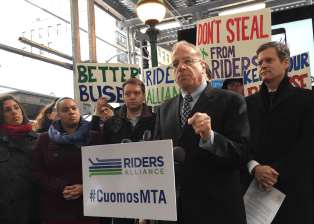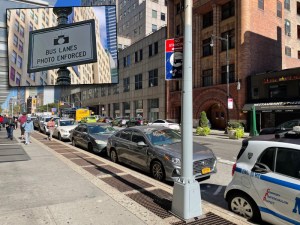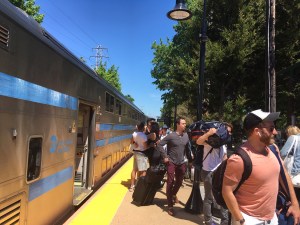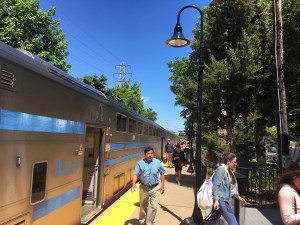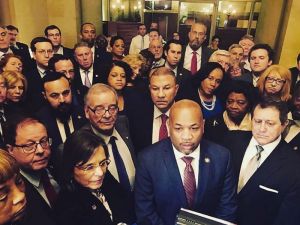ON THEIR MARKS: Legislators Demand More from Hochul’s MTA Budget Proposal
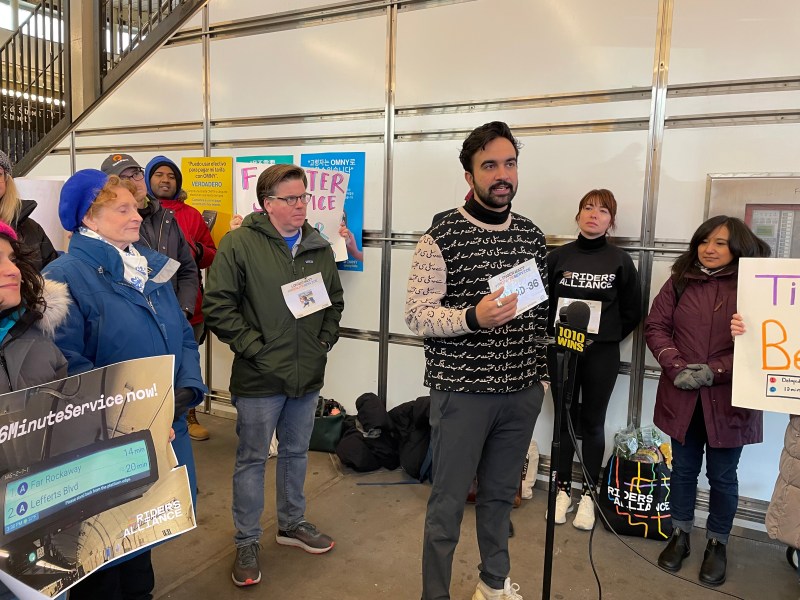
On your mark, get set, go … tell the governor to do better.
Advocates and legislators raced up the stairs of the highest station in the subway system on Friday to press their case for Gov. Hochul to do more to fill the MTA’s fiscal Sarlacc Pit.
“What we have today is a transit system where I had to bike to the train station because I knew that if I didn’t make it there in time, it would be another 20 minutes before I could get here,” said Astoria Assembly Member Zohran Mamdani, before he won the race up the stairs of the celebrated Smith-Ninth Street station in Brooklyn’s Carroll Gardens. “That’s not how we should be living in New York City, and that’s not what we’re going to allow for any more.”
Mamdani, Assembly Member Robert Carroll, State Sen. Andrew Gounardes and Riders Alliance Executive Director Betsy Plum (running for Assembly Member Jo Anne Simon) did the dash up the stairs to press the case for six-minute off-peak subway service, which the racers suggested straphangers could avoid if they knew another train would not be far behind one they might miss. It’s also an achievable goal for the MTA according to transit researchers and advocates.
While we occupied different places on the podium (???), I’m united with my Brooklyn colleagues in our fight to fund #6minservice and #FixTheMTA in this year’s budget.
No New Yorker should have to endure a 10 minute wait for a train.pic.twitter.com/Zvbkcy4HUy
— Zohran Kwame Mamdani (@ZohranKMamdani) February 3, 2023
“Six-minute service is what’s available on more than half of subway lines already during the rush hour, so the MTA is well set up to provide it,” said Riders Alliance Director of Policy and Communications Danny Pearlstein.
The legislators and advocates put on the race because Gov. Hochul’s state budget proposal last week stabilized the MTA’s finances, but did not go any further in providing increased service or heading off a fare hike. The budget directed future gambling revenue to the agency, but that money isn’t expected to materialize until at least 2026, which would leave transit customers waiting around for years.
“We had to first deal with the MTA’s fiscal cliff, and it’s important that we fill the hole,” said Gounardes. “But we all know that we need better service and we need more service. And to get better service and more service we need more funding. So I view the governor’s proposal as a starting point in these negotiations [so] it’s going to be our mission over the next 10 to 12 weeks … that we boost that number as much as possible.”
Hochul’s budget proposal finds $800 million for the MTA by raising the payroll mobility tax and asking New York City to increase its contribution to the MTA’s operating costs by $500 million. The governor also pitched a one-time $300 million injection of state aid for the cash-strapped agency, which faces a $600 million deficit in 2023 and billion dollar-plus deficits from 2024 to 2026. But she also said she was constrained by funding sources she had available to her, which sets her apart from the left wing faction of the legislature that’s pitched ideas like Mamdani’s own Fix the MTA Act or the Invest In Our New York Act, which supporters say could raise $40 billion in tax revenue.
“I do think that the real answer to funding six-minute service, increased bus service and a whole host of the priorities of the fix the MTA platform comes from taxing the wealthiest New Yorkers,” Mamdani said. “There’s so much on the table like the personal income tax and corporate taxes, we can increase the capital gains inheritance taxes. There are a whole host of things on the table.”
